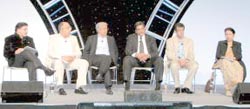India story in Sin City

For eight decades now, it’s been the Woodstock of global content creators, managers and distributors. And at the National Association of Broadcasters (NAB) Show 2008 in Las Vegas, it was, not unpredictably, the Indian media & entertainment (M&E) industry’s chance to grab centre stage.

The India Super Session saw the unveiling of the NAB-commissioned Ernst & Young (E&Y) report on the Indian entertainment economy. “The M&E market in India is at $12 billion (Rs 48,000 crore) and is growing at a fascinating pace of about 18 per cent annually.” Farokh Balsara, National Sector Leader, Media and Entertainment, E&Y, who moderated the India Super session, says the television sector in India is currently valued at $5.7 billion (Rs 22,800 crore), and is expected to double by 2010; subscription revenues, currently negligible, and the evolution of pay TV would be a key driver of this growth. Another driver would, of course, be the rash of channels being launched. “Almost 8-10 channels are launched every month. There is clutter due to that, but this is allowing niche targeting of audiences via content.
Also, there would be consolidation over the next few years,” adds Balsara. The NAB Show was a huge gathering of 105,259; these included 28,310 international attendees, 1,296 members of the news media and 1,650 exhibitors.
So, was it worth the miles clocked for the Indian contingent? Perhaps not, if you ask NAB regular Vivek Malhotra, proprietor of the Mumbai-based FX Graphics, a provider of software and hardware for the animation and post-production industry.
Says Malhotra: “The show was average this year, as I did not see any radical new technologies being showcased in terms of new softwares or solutions. But the conference sessions continue to be useful.”
—Anusha Subramanian










